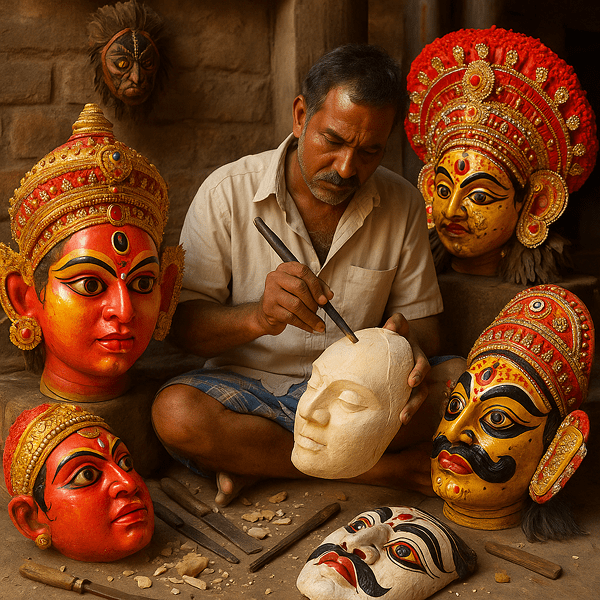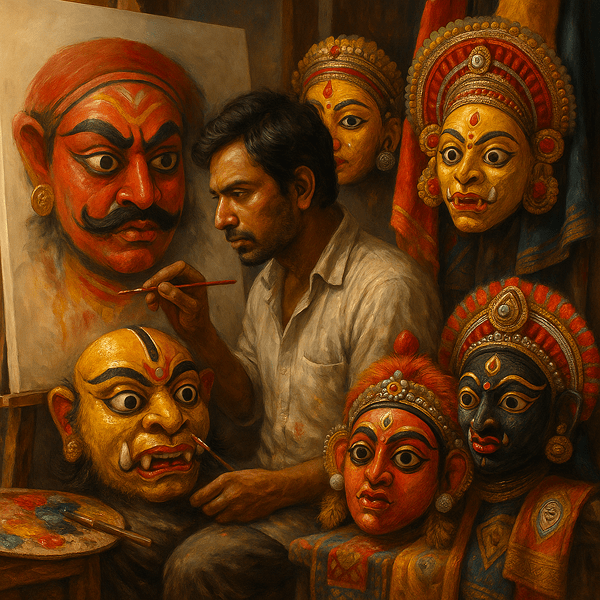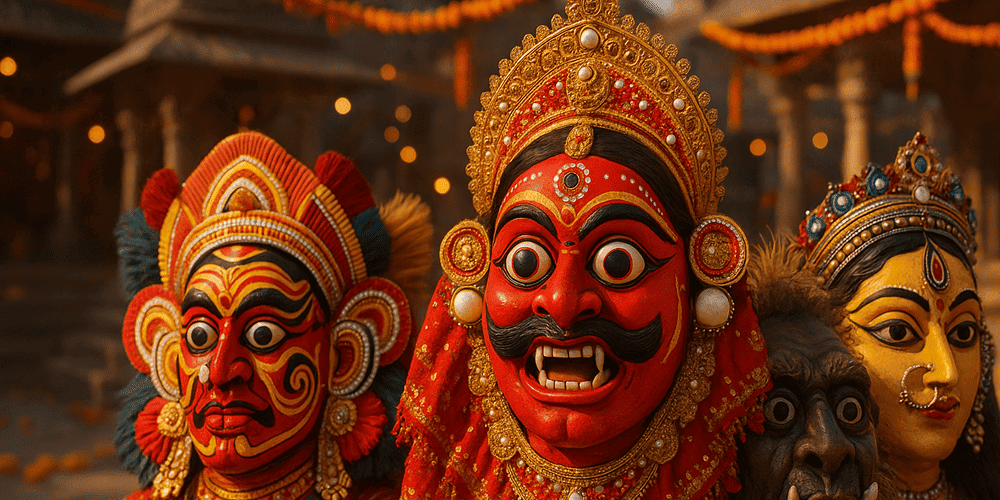Indian Ritual Masks are among the most vivid and culturally significant artifacts in the subcontinent, embodying ancient traditions of spirituality, performance, and community identity. These masks are renowned for their dramatic appearance — often featuring prominent facial features, exaggerated expressions, vibrant colors like red, yellow, or black, and ornate adornments such as beads, feathers, mirrors, and sequins. They can be strikingly lifelike or wonderfully abstract, depending on their ritual purpose and regional style. Indian Ritual Masks are deeply rooted in the religious and folk cultures of regions such as West Bengal, Kerala, Assam, Karnataka, Odisha, and the Himalayan foothills. Their origins span millennia, with some believed to date back to prehistoric animistic rituals, and their use continues to this day in festivals, temple ceremonies, and folk theater.
Historical Origins of Indian Ritual Masks
The history of Indian Ritual Masks is intricately woven into the spiritual and theatrical evolution of the subcontinent. The word “mask” itself is translated into many Indian languages, for example, “mukhosh” in Bengali and “mukha” in Sanskrit and Kannada, meaning “face” or “disguise.” The earliest masks in India were likely used by tribal and village communities for shamanistic ceremonies, ancestor worship, and to invoke or appease spirits. Over centuries, as Hinduism, Buddhism, and local belief systems evolved, masks became integral to temple rituals, classical dances, and epic storytelling. Historical sources, such as ancient temple carvings, illustrated manuscripts, and classical texts, reference the use of masks in religious plays and festivals. During the medieval period, the design and function of masks diversified, influenced by regional customs, trade, and the development of folk and classical theater. Notable artifacts include the Chhau masks of eastern India and the Theyyam masks of Kerala. The evolution of Indian Ritual Masks parallels that of Tribal Masks, which are another important facet of the country’s mask heritage.
Cultural Significance and Symbolism of Indian Ritual Masks
Ritual masks in India are powerful vessels of symbolism and spiritual meaning. In many traditions, a mask is believed to become a living embodiment of the deity, spirit, or mythic character it represents once worn by a performer or priest. This transformation allows for direct communication with divine or ancestral forces, often for the purposes of blessing, healing, or protection. Common motifs include gods and goddesses from Hindu epics, local spirits, animals, and legendary heroes. Myths abound — such as the origin stories of the lion-headed Narasimha or the goddess Kali — where masks play a central role in ritual enactments. The social context is equally rich: masks serve to bring communities together, mark important life events, and teach moral or mythological lessons through dramatic performance. Whether used in a village festival or a temple dance, Indian Ritual Masks are both sacred objects and communal symbols.
Materials and Craft Techniques of Indian Ritual Masks
The creation of Indian Ritual Masks is a highly skilled process, often regarded as a sacred craft. Artisans use locally sourced materials such as wood (mango, neem, kadamba), clay, papier-mâché, bamboo, metal, or even coconut shells. The process begins with the selection and blessing of materials, followed by carving, molding, or layering to achieve the desired form. Tools include knives, chisels, and brushes, as well as traditional techniques such as hand-painting, lacquering, and inlay work. Decorations may include natural pigments, gold or silver leaf, beads, feathers, sequins, and mirrors, each chosen for their spiritual or symbolic resonance. Regional differences are pronounced: Chhau masks from Purulia and Seraikela are known for their papier-mâché and bold facial designs, while Theyyam masks in Kerala are intricately carved and painted, sometimes with attached crowns and elaborate headpieces. Color symbolism is essential: red may denote power or divinity, black protection or the unknown, and white purity or peace.

Functions and Uses of Indian Ritual Masks
The primary function of Indian Ritual Masks is spiritual and ceremonial. They are worn during temple rituals, processions, exorcisms, and seasonal festivals to invoke deities, drive away evil, and bless the land or community. In performative traditions, such as Chhau dance, Theyyam, Bhuta Kola, and Ramleela, masks allow performers to become gods, demons, or mythic beings, enacting stories from the Ramayana, Mahabharata, and local folklore. Masks are also used in healing ceremonies, agricultural rites, and to mark transitions such as birth, marriage, or death. Over time, the use of masks has expanded beyond strict ritual to include public performances, museum displays, and even contemporary art, ensuring that these traditions remain dynamic and accessible in modern India.
Regional Variations of Indian Ritual Masks
India’s vast cultural diversity is reflected in the regional styles of ritual masks. In West Bengal, Chhau masks are bold, colorful, and often depict gods, demons, and animals. In Kerala, the Theyyam and Kathakali masks are elaborate, with striking facial makeup and headdresses. Assam and Arunachal Pradesh feature tribal masks for ancestor worship and harvest festivals, while Karnataka and Tamil Nadu have unique mask traditions for village dramas and Yakshagana dance. Each region’s masks are shaped by local history, mythology, materials, and artistic preferences. Compared to other Asian mask traditions, Indian Ritual Masks are notable for their narrative richness, spiritual intensity, and integration with dance and music. Tribal Masks from central and northeastern India offer further insight into the country’s astonishing diversity of mask-making traditions.
Famous Examples and Collections of Indian Ritual Masks
Some of the most renowned Indian Ritual Masks are associated with the Chhau dance (recognized by UNESCO as Intangible Cultural Heritage) and the Theyyam rituals of Kerala. These masks can be seen in dedicated museums such as the Chhau Mask Museum in Charida (West Bengal), the Kerala Folklore Museum (Kochi), and the Indian Museum (Kolkata). Other significant collections are found at the National Museum (New Delhi), the Tribal Museum (Bhopal), and in private galleries. Archaeological finds of ancient wooden, clay, and metal masks further attest to the antiquity of the tradition. Online galleries, including toddmasks.com, offer virtual exhibitions and expert commentary on Indian Ritual Masks, making them accessible to global audiences.
Influence of Indian Ritual Masks on Art and Culture
Indian Ritual Masks have had a profound impact on theater, visual arts, literature, cinema, and contemporary design. Their vibrant forms and mythological themes inspire painters, sculptors, costume designers, and filmmakers. In literature and film, masks symbolize transformation, hidden identity, and the mystical realms between gods and humans. Ritual mask motifs appear in textiles, jewelry, and festival decorations, reflecting India’s rich heritage in everyday life. The continued presence of mask traditions in public festivals, art installations, and educational programs reinforces their role in preserving cultural memory and fostering creativity.

Contemporary Status and Preservation of Indian Ritual Mask Traditions
Today, the tradition of Indian Ritual Masks is both challenged and revived by changing social, economic, and religious landscapes. While urbanization and modernization have led to the decline of some practices, many communities and artisans actively sustain and adapt their traditions. Master mask makers continue to teach their craft through workshops, apprenticeships, and family lines. Cultural organizations, museums, and festivals support the preservation and innovation of mask culture. Educational initiatives and masterclasses — often highlighted on toddmasks.com — help transmit knowledge to younger generations and international audiences. Artists experiment with new materials, digital media, and contemporary themes, ensuring that ritual mask traditions remain relevant and vibrant.
Collecting and Acquiring Indian Ritual Masks
The market for Indian Ritual Masks includes authentic traditional pieces, high-quality replicas, and contemporary interpretations. Masks can be purchased from artisan cooperatives, museum shops, galleries, and online resources. Prices vary widely, depending on age, craftsmanship, provenance, and artistic value. Collectors should seek expert advice, verify authenticity, and prioritize ethical sources that benefit the artists and communities involved. Toddmasks.com provides guidance on collecting, authentication, and the ethical considerations involved in acquiring ritual masks. Responsible collecting supports cultural continuity, respects sacred traditions, and ensures the sustainability of mask-making arts.
